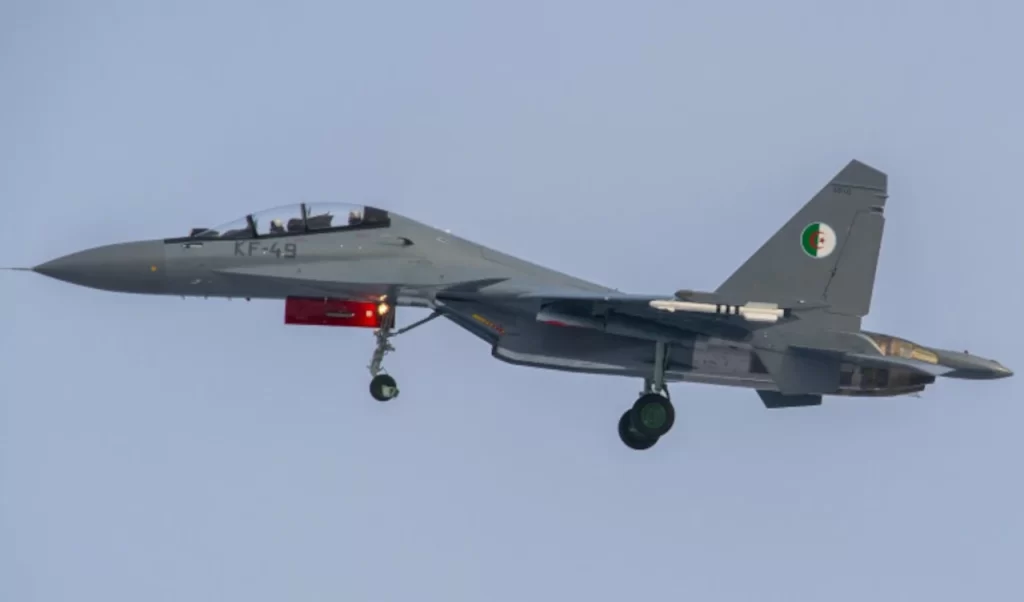The heavy twin-engine fighter Su-30MKA forms the backbone of the combat fleet of the Algerian Air Force. Since its 2009 entry into service, it has been the premier fighter aircraft on the African continent, with unmatched regional capabilities. Algeria ordered the MKA model, which was significantly enhanced by using technologies from the Su-35 and the defunct Su-37. Notably, the NO11M radar was installed on the Su-37, making it one of the first radars in history to use a passive phased antenna array, while the Su-35 was outfitted with a controlled slat, AL-31FP engines and thrust vectoring nozzles. During the Cold War, the Su-27 was regarded as the most effective fighter, but the new Su-30MKA substantially outperformed its efficiency and performance.
The new fighter was created by the largest Russian aviation holding company, JSC Sukhoi, based on the Su-30MKI and Su-30MKM, which were sold to India and Malaysia, with only minor avionics modifications. A high degree of commonality with the production Su-30MKI (and MKM) allowed designers of the Su-30MKA to forgo developing prototypes and immediately begin serial manufacture of aircraft, which were delivered to Algeria upon completion of flight testing. The model was initially designated Su-30 MKI (A).

Since the updated variants of the Su-30 had previously been undertaken in the interest of the Indian Air Force, Algeria’s acquisition of the Su-30MKA included virtually no risk. The Indian Su-30MKI entered service in 2002 and was regarded as the most effective fighter in the world at the time. Due to a long-standing enmity between Algeria and Tel Aviv, the primary difference between the two upgrades was the elimination of Israeli avionics from Indian aircraft.
Beating French Rafales
The light French fighter Dassault Rafale was the leading contender for a position in the future Algerian fleet. Due to its substantially smaller size and lower operational costs, it was significantly cheaper to maintain despite having a comparable price to the Su-30. However, the better specifications of the Su-30 allowed the Russian aircraft to be chosen. The Su-30 could fly much farther and with a much greater combat load, and its situational awareness was also much higher. According to Algerian experts, the capabilities of Russian Su-30 fighters are enough even to withstand fifth-generation F-35 fighters.
However, specs were only one of the reasons Algeria purchased Sukhois. The Su-30 first flew in 1989, whereas the Rafael debuted in 1986. The Su-30s were in service with 12 nations, but the Rafale was flown only by India, Greece, Qatar, Egypt, and France. Algeria chose the Su-30 due to its extensive expertise in operating Soviet aircraft. Not just pilot training and skills, Algeria had the material and technical base for maintenance operations. Algeria did not wish to arm itself with high-tech weapons available to NATO for political and national security concerns. Algeria was especially unnerved by the events in neighbouring Libya, where Muammar Gaddafi was deposed and killed, and French fighters were intimately involved in the state’s conflict.
Su-30MKA Deliveries
In 2006, the first Su-30MKAs were delivered following a huge $8 billion contract. In tandem with the Yak-130 training aircraft and various armaments, 28 MKAs were acquired. Initially, Algeria intended to acquire fewer Su-30MKAs and base most of its fleet on modernised MiG-29s equipped with the same advanced avionics and armament. However, Russia offered only modernised Soviet-built aircraft at that time, not brand-new class fighters. The MiG-29M / M2 are considered a partial replacement of the obsolete MiG-29 Soviet-made, supplied to Algeria from Belarus and Ukraine in the early 2000s.

Algeria’s purchase of MiG-29M/M2 fighters had an essential image value for Russia. In 2007, a contract was signed with Algeria for selling 28 MiG-29SMT fighters and six MiG-29UB fighters, but it was discontinued due to Algerian complaints about the condition of the first delivered aircraft. The Russian Ministry of Defense subsequently acquired these aircraft. This severely damaged the prestige of the Russian side. Algeria intended to purchase Chinese JF-17 fighters or Swedish Gripen fighters to replace its ageing MiG-29s. However, the Algerian military was dissatisfied with these bids.
Thus, Algeria returned the initial MiGs given in exchange for more Su-30s. As a result, the number of Su-30 aircraft ordered climbed to 44 delivered in 2010. The 2006 contract marked the beginning of a significant investment in the modernisation of Algeria’s air defence capabilities, and a 2015 order for 14 additional Su-30MKA aircraft brought the total to 58.
This year, Algeria has earmarked an additional $12 billion for acquiring weapons manufactured in Russia. Thus, Algeria currently ranks second among all buyers regarding the quantity of weaponry purchased from the Russian Federation, behind only India. In addition, Algeria has ordered the Su-57 multifunctional fighter of the fifth generation.
